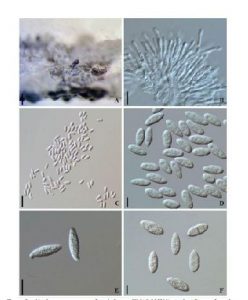Neofusicoccum sinense Y. Zhang ter., M. Zhang sp. nov. MycoBank number: MB 819396
Etymology: The epithet sinense refers to China (from Latin sinensia = China), the country from which it is described.
Ascomata not observed. Conidiomata stromatic, produced on pine needles within 1–2 week, solitary or botryose covered with white mycelium, dark brown to black, initially immersed, 1/2 erumpent through the pine needles at maturity, spherical or elliptical or with central, black ostioles, 200 to 350 μm diam. Paraphyses not observed. Conidiophore not observed. Conidiogenous cells not observed. Conidia hyaline, thin walled, granular cytoplasm, narrowly to broadly fusiform, initially non-septate, subsequently becoming 1–2-septate, constricted at the septum, apex rounded, with somewhat truncate base or sometimes curved node-like, (15.2–) 17.6–20.4 (–23) × (6.9–) 7.4–8 (–9) μm (av. of 20 conidia = 18.7 ± 1.5 × 7.7 ± 0.9 μm, L/W ratio = 2.4). Spermatogenous cells hyaline, slimy cylindrical, smooth-walled and radiating divergent to the surrounding, (10–) 12–13.5 (–15) × 3–5.2 μm, inflated near the base and somewhat tapering upward, apex usually attached to spermatia which is going to fall off. Spermatia hyaline, cylindrical, aseptate, sometimes with arc bending, 5 × 3 μm.
Cultural characteristics: Colonies on MEA iron-grey (surface) and olivaceous- grey (reverse) with extensive grey aerial mycelium, and smooth margins, attaining a radius of 20 mm after 3 days in darkness at 28°C, aerial mycelium growing upward like conical antenna and eventually form the bowl colony about 10 days, tapered tip and part with slowly atrophy then flattened with tufts, its color transition from white to grey or ash grey after 25 days.
Specimens examined : CHINA, Guizhou Province, Huangping County, Fengxiangzhai (altitude: 1,000 m), from branch of unknown dead woody plant, 20 Feb. 2016, J.J. Gan (holotype: HMAS 255209; culture ex-holotype: CGMCC 3.18315).
Notes : Phylogenetically, N. sinense is sibling to other species of Neofusicoccum, while closely related to N. brasillense, N. grevilleae and N. kwambonambiense (Fig. 1). Morphologically, the conidia of N. sinense are initially non-septate but subsequently become 1–2-septate. Neofusicoccum brasiliense failed to sporulate in culture, thus its description was based solely on molecular data (Marques et al. 2013). The small-sized conidiomata (< 200 μm), larger conidia (20–32 × 6–10 μm) and the phialidic conidiogenous cells of N. grevilleae are distinguishable from those of N. sinense. The presence of spermatia, smaller conidia and lower L/W ratio of N. sinense (18.7 × 7.7 μm, L/W = 2.4) are distinguishable from those N. kwambonambiense (22.3 × 6.3 μm, L/W = 3.6). Thus, a new species, N. sinense, is introduced here.
FIG 3 . Neofusicoccum sinense (from holotype: HMAS 255209). A Conidiomata formed on pine needles in culture; B Spermatogenous cells with developing spermatia; C Spermatia; D Hyaline, aseptate conidia; E Hyaline, aseptate conidia with a curved node-like base; F 1- or 2-septate, hyaline, senescent conidia. Scale bars: A = 300 μm, B–F = 10 μm.

